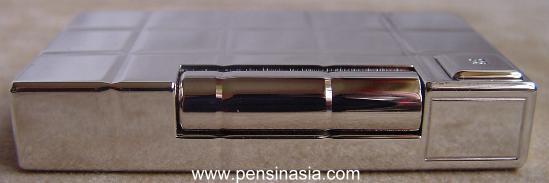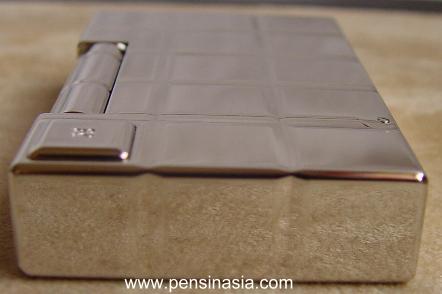In
1872, Simon Tissot Dupont established a luxury leather goods company in
Paris. His
designs were immediately successful and highly esteemed by the elite.
In the 1920s, kings and queens, politicians and artists were wildly
enthusiastic about the magnificent luggage creations and their matching
accessories.
Styled in the rarest and most precious materials, the production of
these masterpieces involved no less than 17 different craft techniques:
crystal specialists, leather craftsmen, silversmiths and goldsmiths,
lacquerers.

Until
the Second World War, S.T. Dupont supplied the world's rich and famous.
In 1939, the disappearance of this clientele and the shortage of
precious materials forced the company to look for different activities. The
first new product to be launched was the aluminium petrol lighter. On 6th
January 1941,
S.T. Dupont patented
its creation. In these grim times, the new product was greeted with
enthusiasm. In fact so much so that after the war, this product, which was
originally intended as a substitute, actually became the main activity of
the company.

In
the 1950s the world embarked on reconstruction.
After years of hardship, people were in need of luxury and something
to dream about.
At
the cutting edge in terms of research, S.T. Dupont patented a gas lighter on
18th July 1952.
This new
lighter was given the same timeless, refined, parallelepipedic shape as the
petrol lighter.
A marvellous example of mechanical precision and perfect finishes, it
was composed of no less than 40 different pieces.
Manufactured in brass, with gold or silver plate or Chinese Lacquer,
it was decorated with fine, graphical guilloche ornamentation.
In this same year, the company decided finally to stop the production
of travel items.

The
flourishing, frenzied 60s marked a glorious decade for the company.
The S.T.Dupont lighter fitted perfectly into the consumerist era.
It became a cult object, a symbol of power and social success.
The perfect, rectangular shape of the lighter assumed almost mythical
proportions.

In the 70s and 80s, the consumer society and the importance of
external appearances reached a peak.
In response to this sociological and economic reality, S.T.Dupont
created, in 1977, a new lighter known as the Ligne 2. Slimmer and bolder,
this new object was endowed with a very special feature: the opening of the
lid generated a characteristic noise known as the "Cling".
This unique crystal-clear sound, instantly identifiable, became a
sign of recognition among the upper classes, especially in Asia.
And so S.T. Dupont added the sophistication of perfectly designed
sound to the aesthetic beauty of the product.

During
the 1980s, women clamoured for equality and with it they claimed the right
to use the same symbols.
In 1985,
S.T. Dupont offered
them a miniature version of the lighter. Compact and lightweight, the Ligne
D model became a companion for women and was a particular favourite among
the new breed of career women.

In
1989,
in the same spirit of
making things smaller, S.T. Dupont launched the GATSBY.
For the first time, this lighter was decorated with the double
gadroon symbol, a small curved rectangle that expresses the full essence of
the brand: accuracy and balance.
Thereafter, this symbol was used to sign all S.T. Dupont creations.
In
the 90s, design became a major cultural influence and a reflection of values
and attitudes, In 1999,
S.T. Dupont produced
its contemporary interpretation of the antique hammer lighter, originally
found in the earliest travel sets.
With the creation of the Urban lighter, S.T. Dupont successfully
married luxury and industrial design.
2001.
60 years on, the S.T. Dupont
lighter remains a mythical object in all its monolithic, graphical splendour.
Through its stunning geometric lines and daring architectural design,
it continues to assert its modernity and timelessness.

Dimensions
Length :
62 mm (2.4")
Width
: 37
mm (1.5")
Thickness
: 11.5
mm (0.5")
